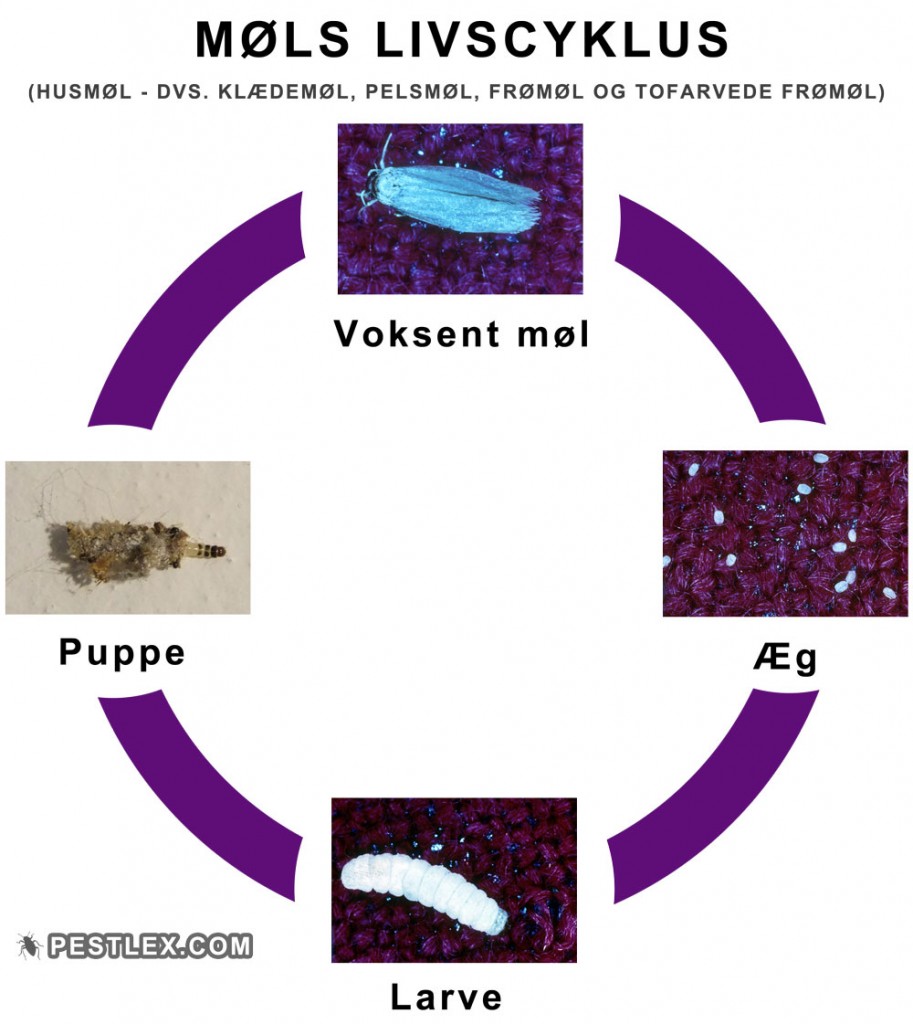Clothes moth traps, flour moth traps and moth bags is recommended for moth prevention and control:
The 4 stages of the lifecycle
Most moths have a life cycle that can be divided into 4 stages:
- Adult moth
- Eggs
- Larva
- Doll
You'll find a more detailed breakdown of this cycle below.
NOTE: This article is only about house moths (i.e. clothes moths, fur moths, seed moths and two-colored moths) - not the other 160,000 moth species!

Life cycle steps
Moths lifecycle can be divided into 4 steps:
1. Adult moth
- ParringThe adult moths mate immediately after emerging from their pupae (the timing of mating varies from species to species, but often occurs within the first few days after hatching - and within the first few weeks at the latest). The total lifespan of adult moths can range from a few days to just over a month.
- Egg laying: The adult moths lay their eggs directly on the larvae's future food source. For the clothes moth For food moths, this is organic textiles (e.g. in a clothes cupboard) and for food moths, it's dry food (e.g. in a kitchen cupboard). However, some species can also lay their eggs on plant or animal materials. The number of eggs laid depends on the species of moth and can be between 40 and 600 in the lifetime of the moth.
2. eggs
- Time of hatching: When the eggs hatch is highly dependent on the temperature and humidity of the environment (and the species of moth), but under the right conditions, hatching typically occurs in 4-30 days. However, it can take several months.
- The hatching itself: When the egg hatches, the moth larva emerges and immediately starts feeding on the nearest food source - which is usually the material it hatched on. Read more about moth eggs here.
3. Larva
- Food: The larval stage starts when the larva hatches, where it begins to feed on its surroundings. If the larva is not on a material it can feed on, it will immediately seek out a suitable material. For example, clothes moths can gnaw through synthetic textiles to gain access to organic textiles (which they can feed on), just as food moths can crawl through very small holes in packaging to gain access to the food inside.
- NutritionThe moth caterpillar needs a lot of nutrition to develop into an adult moth in the next stage, the pupal stage. During the larval stage, the caterpillar molts 5 - 45 times. Larvae that hatch in places with sufficient food hardly move around. Larvae that lack food, on the other hand, will seek it out as actively as possible and will therefore wander around. The total duration of the larval stage varies greatly and depends mainly on temperatures and humidity, but also on the moth species. The larval stage can last from 35 days to 2 ½ years.
4. doll
- DollsThe caterpillar spins a pupa (cocoon) in which it pupates. The purpose of this is to protect the larva from desiccation and other environmental disturbances while it develops into an adult moth. The pupal stage starts when the larva pupates and ends when the adult moth emerges from its pupa. Like the other stages, the duration of the pupal stage depends on the environment and the species of moth.
- BehaviorDifferent moth species have different behaviors in the pupal stage. For example, fur moths wander around dragging their pupa with them, whereas other moths have their pupae attached to their food sources and don't move around.
Generations
Between 1 and 9 generations can occur per year. The number of generations is highly dependent on the type of turbine and the temperature and humidity of the environment.
The optimal temperatures are between 20 and 30 degrees for each species. All moths, larvae and eggs will die if heated to 60 degrees for one hour. They can survive frost, but the vast majority die at -18 degrees (for at least 2 days). They are also very sensitive to large temperature fluctuations, so alternating cold and heat will kill them.
Humidity is especially important for seed moths, whose development slows or stops if there is insufficient moisture in the environment.
Additional information
If you have a moth infestation and are unsure which species of moth it is, you can find out in our guide to moth species.
You can also read more about the life cycles of individual moth species in their respective articles:
